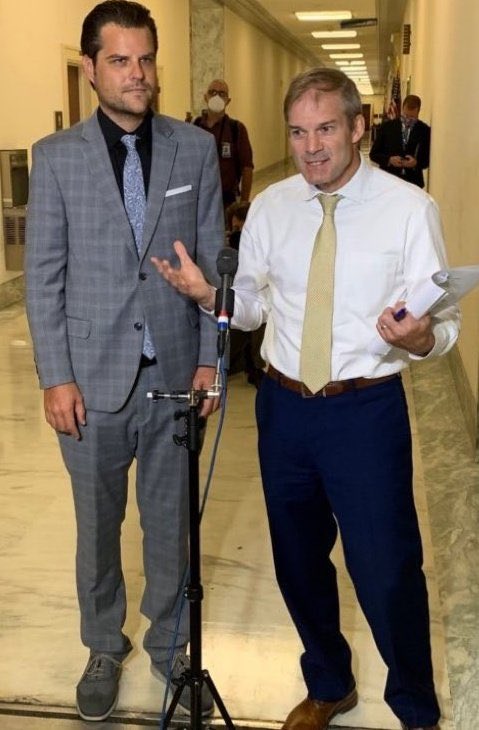One sidesism

Jon Allsop is convincing that calling blame-the-Republicans-actually-torpedoing-a-1/6-commission-last coverage “both-sidesism” is too generous:
Banks had been overtly hostile to the prospect of the committee and Jordan may be a material witness to Donald Trump’s complicity in the insurrection; both men voted to reverse Trump’s defeat in key states, abetting the Big Lie that incited the insurrection in the first place. Pelosi’s decision not to seat them thus looked like a move to shore up the credibility of the committee’s investigation against inevitable bad-faith attacks from within. And yet a number of journalists and commentators reached very different conclusions. Rachael Bade, of Politico, said that Pelosi had given a “gift” to McCarthy: “He wanted this panel to look partisan and political. Now it’s definitely going to look partisan and political.” Politico’s DC Playbook team, of which Bade is a member, wrote that, while it had called out Republican “cowardice” in rejecting the idea of a commission, Pelosi’s decision “will make the investigation even easier to dismiss for people who aren’t die-hard members of Team Blue,” arming the GOP with a “legitimate grievance.” Chris Cillizza, of CNN, told anyone still harboring hopes that the committee might deepen public understanding of January 6 to “give up on those hopes now,” because Pelosi had just “doomed” them. (Confusingly, Cillizza then went on TV and pinned most of the blame on McConnell.) The Hill wrote that Pelosi had helped Banks burnish his “brand.” And so on.
This genre of coverage—and Playbook’s analysis, in particular—attracted some intense criticism online, with numerous media-watchers characterizing it as the latest iteration of a familiar journalistic problem: bothsidesism. The New Republic’s Alex Shephard wrote, in an article headlined “Both Sides Journalism Will Never Die,” that many political journalists treated Pelosi’s decision as “just another sigh-inducing instance of partisanship in Washington”—a position Shephard paraphrased with the question: “Why can’t both parties just stop messing around and get things done? If only Nancy Pelosi would stop playing politics and allow people who tried to overturn a legitimate presidential election to serve on a committee investigating a violent attempt to overturn a legitimate presidential election!” Salon’s Amanda Marcotte agreed: everyone knows that the GOP wants to derail the January 6 investigation, she wrote, “and yet, because the slow decline of our democracy is like a horror movie where the scantily clad young woman is ignoring audience pleas not to go down that dark hallway, the mainstream media is framing this as a ‘both sides’ problem.” Speaking on Pod Save America, NBC’s Mehdi Hasan said that the insurrection led to hope that journalists might abandon the both-sides approach—and yet, six months on, “the ‘legitimate grievance’ is the pro-insurrection party complaining that they don’t get to be on the insurrection investigation.”
This is, indeed, bothsidesism as we’ve come to understand the term, insofar as it bent over backward to find Democratic culpability in a problem that Republicans created. But this understanding arguably reflects a slippage from a clear-cut understanding of the term that, to my mind, was once more prevalent in gripes about political coverage, especially early on in the Trump era: namely, the idea of false equivalence, or treating two things that aren’t the same as if they are. Much of the coverage of Pelosi’s decision fit this classic frame—casting it as part of a “partisan brawl,” or juxtaposing soundbites from Pelosi and McCarthy without adding much context. The most objectionable coverage, however, committed far graver sins; arguably, the worst of it was so bothsidesy that it approached onesideism, scolding Democrats while letting Republicans off the hook. This is itself a much broader problem than mere false equivalence, reflecting—as Brian Beutler, of Crooked Media, and others have put it—the commonplace journalistic assumption that “Republican bad faith… is just a feature of the landscape,” whereas a given Democrat is “an actor with agency, and subject to scrutiny.” This problem, as Hasan noted, has an analytical cousin: in the eyes of many pundits, a given political development is often framed as being Bad News for Democrats, but not for Republicans.
The internal tension within this coverage make clear that there’s little to no genuine misunderstanding of what’s going on. It’s almost universally understood that Republicans are acting in pure bad faith; there are just some reporters who erroneously think good journalistic practice requires reporters to pretend to believe them.


